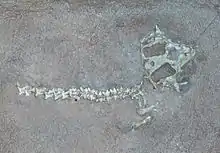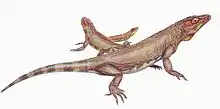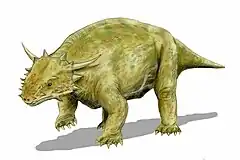Hypsognathus
Hypsognathus (from Greek: ῠ̔́ψος húpsos, 'height' and Greek: γνάθος gnáthos, 'jaw') is an extinct genus of procolophonid parareptile from the Late Triassic of New Jersey, Connecticut, and Nova Scotia.[1]
| Hypsognathus Temporal range: | |
|---|---|
 | |
| Fossil of Hypsognathus fenneri (AMNH 1676) in the American Museum of Natural History | |
| Scientific classification | |
| Domain: | Eukaryota |
| Kingdom: | Animalia |
| Phylum: | Chordata |
| Class: | Reptilia |
| Clade: | †Parareptilia |
| Order: | †Procolophonomorpha |
| Family: | †Procolophonidae |
| Subfamily: | †Leptopleuroninae |
| Genus: | †Hypsognathus Gilmore, 1928 |
| Type species | |
| †Hypsognathus fenneri Gilmore, 1928 | |

Hypsognathus resembled a moderately sized lizard, with a length of 33 centimetres (13 in), although it was unrelated to modern lizards. Because of its broad teeth, Hypsognathus is thought to have been a herbivore. Its body is low and broad and it has a relatively short tail. Hypsognathus has some spikes on the side of its head, probably for protection against predators.[2]
Multiple specimens from the Magnesian Conglomerate of England that were discovered during the 1970s by Jeanne Evans were initially referred to cf. Hypsognathus in 2016[3] before being moved to a separate species, Hwiccewyrm trispiculum in 2023.[4]
References
- Sues, H.-D.,Olsen, P.E., Scott,D.M, and Spencer, P.S. (2000). "Cranial Osteology of Hypsognathus fenneri, a Latest Triassic Procolophonid Reptile from the Newark Supergroup of Eastern North America" Journal of Vertebrate Paleontology, 20(2):275-284.
- Palmer, D., ed. (1999). The Marshall Illustrated Encyclopedia of Dinosaurs and Prehistoric Animals. London: Marshall Editions. p. 63. ISBN 1-84028-152-9.
- Whiteside, D. I., Duffin, C. J., Gill, P. G., Marshall, J. E. A., & Benton, M. J. (2016). The Late Triassic and Early Jurassic fissure faunas from Bristol and South Wales: Stratigraphy and setting. Palaeontologia Polonica, 67, 257–287.
- Butler, R. J.; Meade, L. E.; Cleary, T. J.; McWhirter, K. T.; Brown, E. E.; Kemp, T. S.; Benito, J.; Fraser, N. C. (2023). "Hwiccewyrm trispiculum gen. et sp. nov., a new leptopleuronine procolophonid from the Late Triassic of southwest England". The Anatomical Record. doi:10.1002/ar.25316. PMID 37735997.






